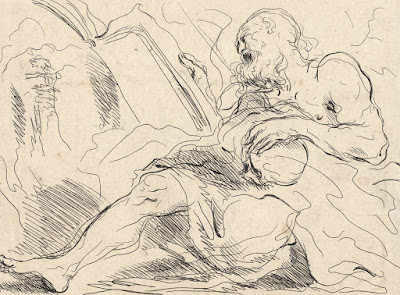Heinrich
Theodor Joseph Bislinger (1742-1774) and/or Johann Gerhard Huck (c.1759–1811)
Although the British Museum proposes that Huck may be involved in
the execution of this particular plate (see BM no. 1858,1113.247) I have
reservations about this attribution. The reason—and I may be very wrong—is that
when this plate was executed in 1781, it was a year before Huck began his
training as a pupil of Valentine Green from 1782 to 1788 and was not at this
time involved in the series of plates reproducing drawings from the Dusseldorf
Gallery. Nevertheless, after completing his training the BM advises that he
worked on the plates as Green's agent in engraving the Dusseldorf Gallery
prints and both engravers names are inscribed on the first plate of the series
“Gravées par Theodor Bislinger et Gerard Huck” (see BM no. 1858,1113.229).
“Saint Jerome”, 1781, after Guercino
(aka Barbieri, Giovanni Francesco Guercino) (1591–1666), from the series of
fifty etchings, “Collection d'estampes d'apres les desseins originaux”, after
drawings in the collection of the Academy of Düsseldorf, published by the
artist and Johann Gottlieb Prestel (1739–1808)
in Amsterdam, Düsseldorf and Nuremberg.
Etching on cream laid paper trimmed on or within the platemark and
backed with a support sheet.
Size: (sheet) 16 x 20.2 cm; (image borderline) 13.3 x 18.1 cm
Inscribed on plate below the image borderline; “Saint Jerome—par
Guercino da Cento”
The British Museum offers the following description of this print:
“Saint Jerome in the desert reading and turned left, after
Guercino (?). 1781 Etching”
Condition: crisp and well-printed impression with no sign of wear
to the plate. The sheet has been trimmed along, or within, the platemark and
laid upon a support sheet of archival (millennium quality) washi paper. The
sheet has thin areas (verso) but this issue is not visible on the front,
otherwise the print is in very good condition.
I am selling this etching capturing the fluid strokes of Guercino's pen
drawing of Saint Jerome as he symbolically holds a skull while reading—an activity
that the saint is attributed with the insight: “When we pray, we speak to God;
but when we read, God speaks to us”—for the total cost of AU$126 (currently US$93.98/EUR79.39/GBP69.81)
including postage and handling to anywhere in the world (but not, of course,
any import duties/taxes imposed by some countries).
If you are interested in purchasing this fascinating print what
would have been closely studied by art students wanting to see an example of Guercino's intuitively searching and expressive pen strokes, please
contact me (oz_jim@printsandprinciples.com) and I will send you a PayPal
invoice to make the payment easy.
For those looking for a very good example of the “return stroke”
(i.e. a quickly scribbled zigzag line) then this etching is perfect. This
stroke may seem like a very ordinary type of lightly laid line that an artist might
make when casually “blocking-in”/approximating an area of tone—and it is! In the
history of printmaking, however, this mark has a well-documented history that
reveals that the use of such a line is far from “ordinary,” beginning with the
first artist to use it: Antonio del Pollaiuolo (1431–1498) in his large and
only engraving, “Battle of the Nudes”, c. 1470. What makes Pollaiuolo’s use of
the return stroke fascinating is that he contrived the “look” of the quick mark
that one might make with a pen using the engraver’s tool, the burin, which is
almost impossible to use for creating continuous zigzag line ... until Pollaiuolo showed how it could be
done.
I should mention at this point that Bislinger’s etching also
reveals an understanding of the “hook stroke” (i.e. the same quickly scribbled
zigzag line of the return stroke but with the “return” leg of the stroke suggested
by the trace of a hook-like twist of its start and conclusion) as may be seen
in the same areas of the drawing as before. Historically this hook stroke also
had a famous practitioner exploring its use: Francesco Rosselli (c. 1445–before
1513) whose engraved lines retain the “hooks” of the return strokes (see David Landau
& Peter Parshall 1994, “The Renaissance Print 1470–1550”, Yale University
Press, New Haven, p. 73).







No comments:
Post a Comment
Please let me know your thoughts, advice about inaccuracies (including typos) and additional information that you would like to add to any post.